SPMTs remain wheeled wonders
The self-propelled modular transporter (SPMT) is a critical tool in many industry sectors worldwide. With independently controlled axles, they are capable of motion in all directions, even 360-degree movement, and can compensate for uneven ground.
Bridge girder placement
Barnhart Crane & Rigging has long used SPMTs for its rigging projects. SPMTs were the perfect tool for a Barnhart project in Jackson, MS to set 21 bridge girders on three different spans on an interstate highway. The project is part of a major Mississippi Department of Transportation plan to improve traffic flow at the I-55/I-20/Hwy 51 junctions.
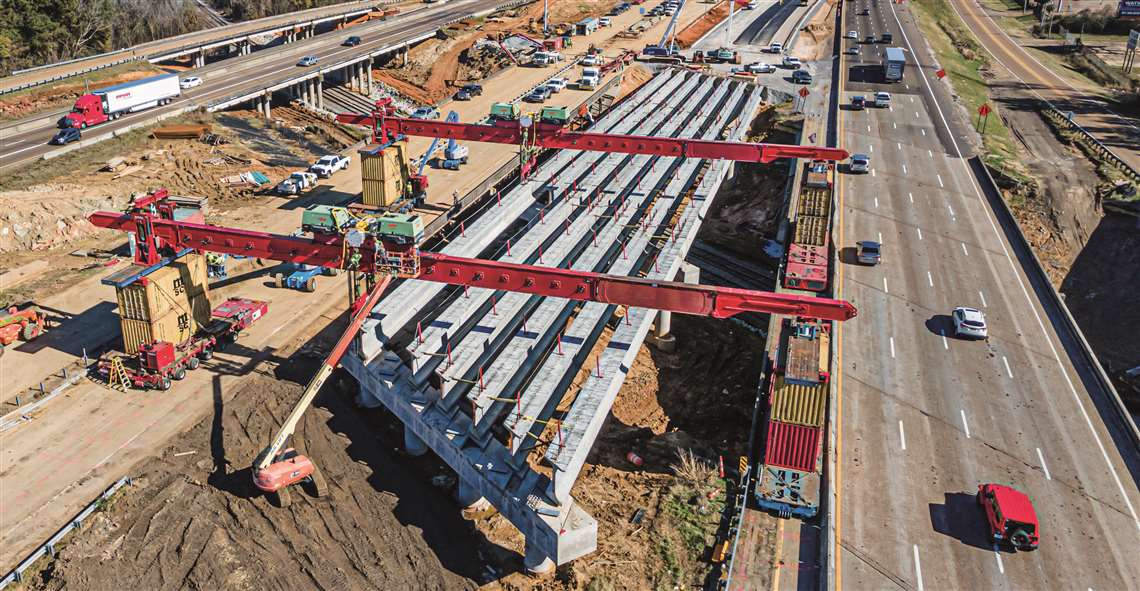 Barnhart set up the SPMT system on a closed roadway to receive the girders and maneuver them into place.
Barnhart set up the SPMT system on a closed roadway to receive the girders and maneuver them into place.
Barnhart engineers developed a system using two 9-line, single wide SPMTs and two 6-line, 1.5 wide SPMTs. The decks were topped with 20-foot intermodal containers to reach the needed working height. The different PST configurations were required to meet bridge loading criteria on the existing bridges supporting the SPMTs.
The pre-stressed concrete girders weighed between 138,000 and 203,000 pounds. The longest ones were 170 feet in length. The girders were brought in on a closed roadway and the team lifted and set each one into place.
The two sets of PSTs were spaced 133 feet apart and separated by the new bridge. One set was on a Hwy 51 bridge during the lifts while the other PSTs were on an I-20 bridge. Barnhart riggers and iron workers used the 1,000-ton slide system to safely control the lateral shift of the girders and air hoists to compensate for various placement heights.
The SPMT system had many advantages. It was easy to mobilize and allowed Barnhart to relocate the lift system to the next girder while meeting the loading requirements. It also allowed for elevation changes from span to span in order to keep the entire system level. Despite delays associated with the girder delivery to the site, Barnhart still completed the project ahead of schedule and under budget.
The project involved several firsts. It was the first time in MSDOT history that SPMTs have been used to set bridge girders. Another first, the 170-foot pre-stressed girders were the longest ones of that style set in the state to date.
Berard moves big things all the time, but the 1,300-ton stacker-reclaimer job was quite the spectacle.
 Berard engineers and project managers teamed up to support and lift the cargo safely and then rotate it 90 degrees to begin the transport phase.
Berard engineers and project managers teamed up to support and lift the cargo safely and then rotate it 90 degrees to begin the transport phase.
The stacker measured 288 feet long, 53 feet wide and 130 feet tall, and the conveyor was 160 feet long, 45 feet wide and 60 feet tall.
Berard engineers and project managers teamed up to support and lift the cargo safely and then rotate it 90 degrees to begin the transport phase. The cargo was transported about 400 yards and then lowered onto a set of rails. Once this phase was completed the team transported two large conveyor structures to the same location to be joined with the stacker-reclaimer.
The critical equipment used included 64 lines of Tii Scheuerle SPMTs, five power packs, beams, stands and steel plating.Moving a refractionator tower in Canada
Transporting and installing a 52-meter, 180-metric ton refractionator tower is no simple task, but with the expertise of the Sarens’ team, anything is possible.
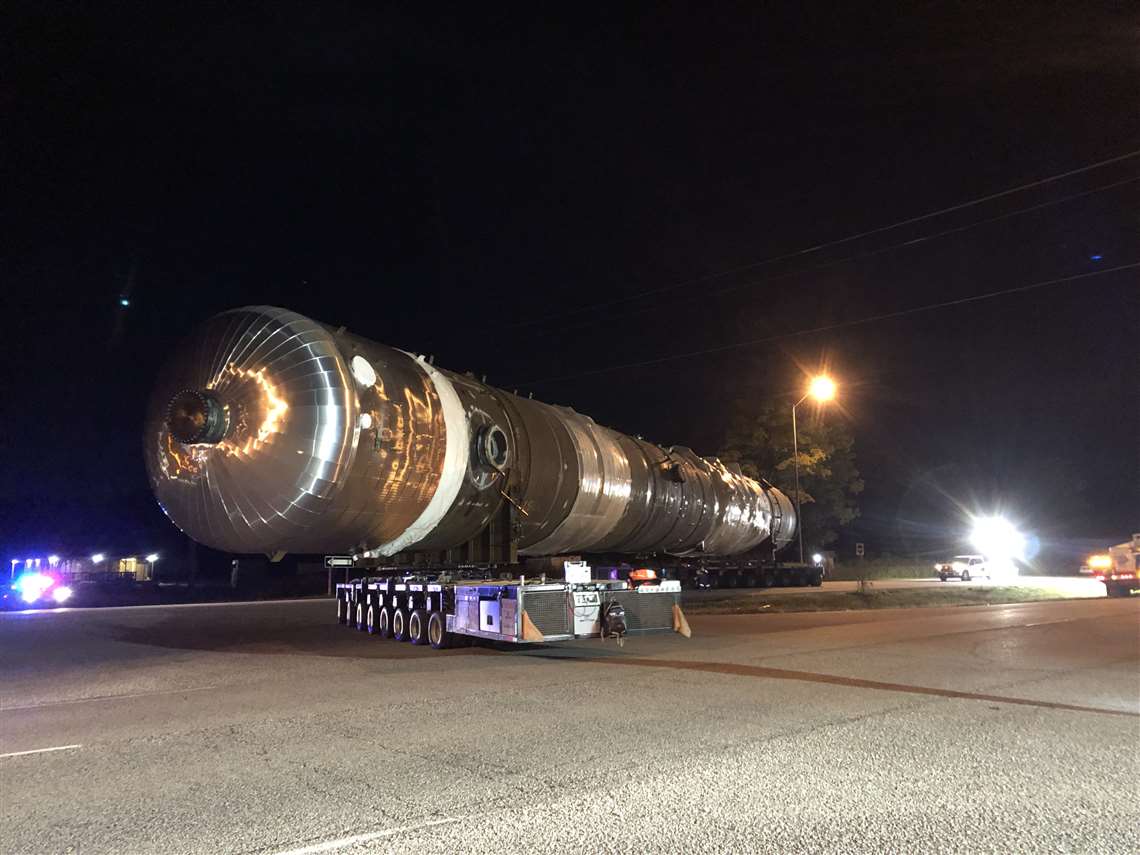 Two SPMT operators, one transport supervisor and two Sarens escorts were involved in the transportation operation.
Two SPMT operators, one transport supervisor and two Sarens escorts were involved in the transportation operation.
Working for Imperial Oil, Sarens developed a SPMT transport system to haul the tower across public roadways and to the installation site. The haul required collaboration and cooperation on a large scale, including civil works to widen the road over three turns, power supplier escorts for passing under high-voltage lines, facility pipe rack height clearances and super load permits from MTO, the city of Sarnia and the county of Lambton.
The transportation route was 13.7 kilometers long, with six 90-degree turns. It required passing over two culverts with steel ramps, and under four high-tension power lines.
The main challenge Sarens faced was transporting this super load through a town without a heavy haulage corridor. Sarens had to carefully plan, design and supervise the civil works required to make it possible, as well as obtain all the necessary permits to remove route signs and pass under power lines.
One mobile crane (Liebherr LTM-1100), one operator, two riggers and one supervisor were involved as assisting crew to set up ramps for transport. Four super load escorts, seven bucket trucks and five police escorts provided support.
Custom job
In support of a plant upgrade, a petrochemical company in Louisiana needed to transport several large vessels from a cargo ship to their site. The weight and height of three of these vessels posed challenges for the contractor in the way of severe height restrictions from a pipe rack along a public road.
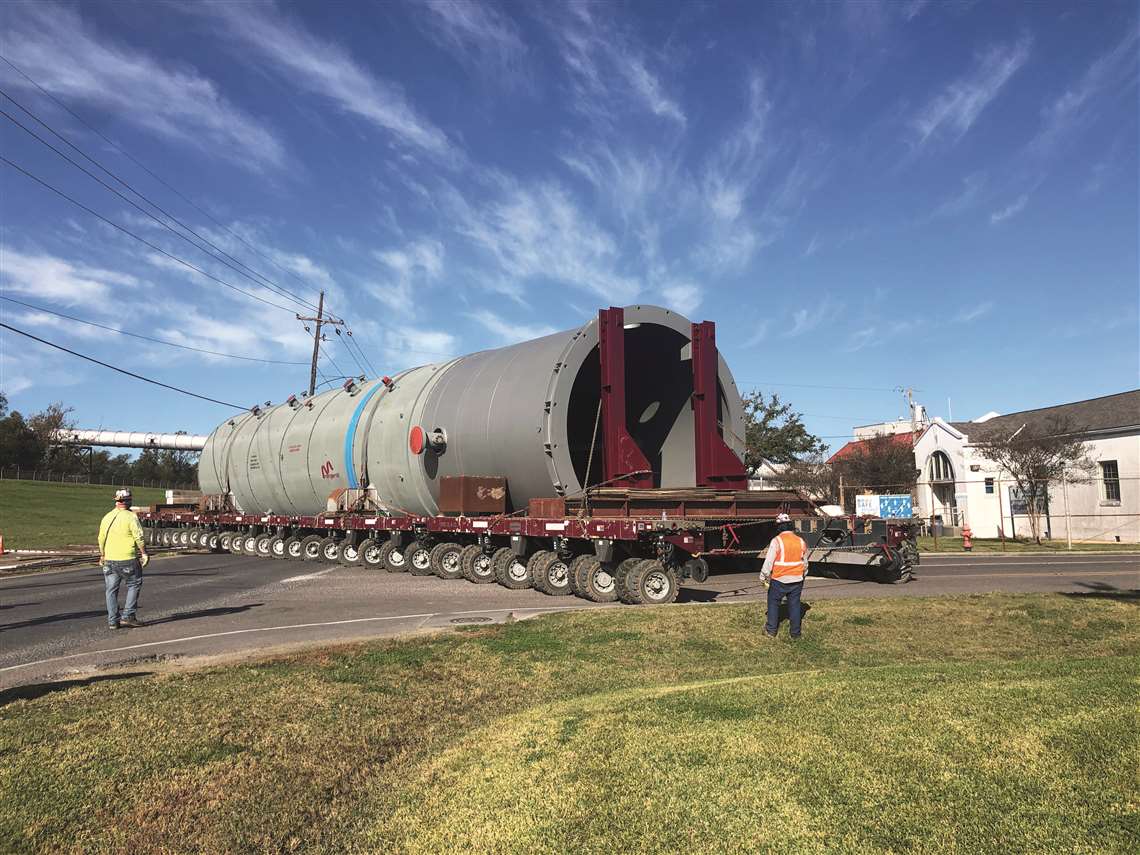 Deep South crews rolled the vessels off barges onto two separate double wide 18 lines (36 lines total) and staged them on cans and mats.
Deep South crews rolled the vessels off barges onto two separate double wide 18 lines (36 lines total) and staged them on cans and mats.
Two of the vessels weighed 919,328 pounds and extended 105 feet long, 19 feet 9 inches tall and 25 feet 2 inches wide, respectively, and the third weighed 859,801 pounds and was 100 feet 11 inches long, 19 feet 8 inches tall and 25 feet 2 inches wide. The combined trailer and vessel weight of the largest would be 1,248,000 pounds, 142 feet 11 inches long, 25 feet 2 inches wide and 19 feet 10 inches tall (at lowest stroke) with another two inches for mid stroke.
Standard SPMT transporters were not suitable for the scope and scale of this transport given the height challenges. Instead, Deep South custom designed a SPMT for safe hauling.
Split configuration
Typically, “split-configuration” SPMTs are divided down the middle of the spine beam of a single file trailer, allowing the trailer to widen and using bolt-in cross beams to increase stability. For this project, Deep South reconfigured a split-configuration SPMT, removing the crossbeams and installing specially designed saddles that allowed the vessels to sit inside the split trailer configuration to reduce the overall transport height.
To use the specialized split configuration, state regulations required Deep South to extend the trailer to meet weight-per-tire permit limits. Potential trailer deflection due to the longer length was resolved with custom-designed and fabricated bolt-on skirt beams that placed weight from the tail end of the vessel to the trailer. Deep South attached standard double-wide four lines at the split trailer power packs to increase side-to-side stability. The total width of the trailer was 25 feet, tire-to-tire, allowing the vessel to sit inches above the ground for maximum height reduction.
 Deep South reconfigured a split-configuration SPMT, removing the crossbeams and installing specially designed saddles that allowed the vessels to sit inside the split trailer configuration.
Deep South reconfigured a split-configuration SPMT, removing the crossbeams and installing specially designed saddles that allowed the vessels to sit inside the split trailer configuration.
With the custom split trailer SPMTs designed and approved, the transport project moved forward. Deep South crews rolled the vessels off barges onto two separate double wide 18 lines (36 lines total) and staged them on cans and mats. An 800-ton gantry lifted each vessel from the double-wide trailers onto the custom split trailers.
Increased ground stability
The majority of the transport was along a double-lane road. Road plate and laminated mats were placed off-road to increase ground stability. Once near the pipe rack, which was located close to a railroad track, mat pads were laid before and after railroad tracks to smooth out the elevation changes.
While the trailer had less than 6 inches of clearance near the pipe rack and less than 2 inches of clearance from saddles to rail tracks, the move went off without a hitch.Furnace removal and replacement
Edwards Moving and Rigging (EMR) was contracted to provide the equipment and personnel to perform a challenging furnace replacement at a steel plant in Southeastern Ohio. Both the new and existing furnaces weighed 800,000 pounds. The plan by Edwards was to utilize two Goldhofer 12-line PST configurations tied together electronically for the changeout.
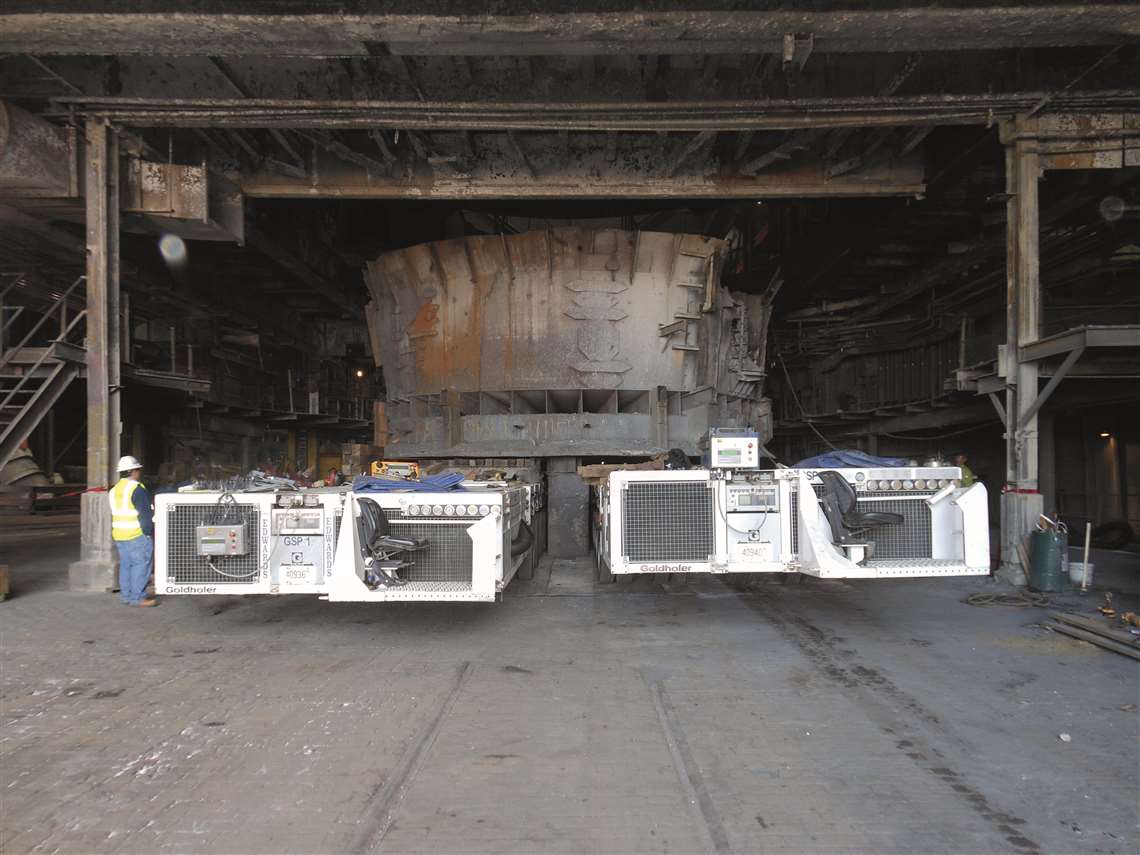 Edwards Moving and Rigging (EMR) was contracted to provide the equipment and personnel to perform a challenging furnace replacement at a steel plant in Southeastern Ohio.
Edwards Moving and Rigging (EMR) was contracted to provide the equipment and personnel to perform a challenging furnace replacement at a steel plant in Southeastern Ohio.
The existing furnace was sitting on piers, so the first action by Edwards was to maneuver the two Goldhofer trailers between the piers to a lifting point under the furnace. Edwards then used the stroke of the trailer to elevate the furnace off the piers. The challenge was heightened by an obstruction between the location of the furnace and the exit door, as there was an immovable obstacle that would result in less than three inches of clearance. It became imperative that the travel height be exact as the presence of the piers would not let the trailer be lowered and due to the obstacle, it could not be raised.
EMR safely navigated the heavy furnace under the overhead obstruction and through the doorway, moving it to a staging location where it was lowered using the trailer. The new furnace, while the same weight, was shorter in height and the procedure worked in reverse with a more comfortable overhead margin. Edwards, using the dual Goldhofer trailers, completed the setting of the new furnace onto the piers.
Multiple route surveys were performed prior to the transport and a team of four spotters, along with the operator, were used to transport the vessel to the cranes for final set.
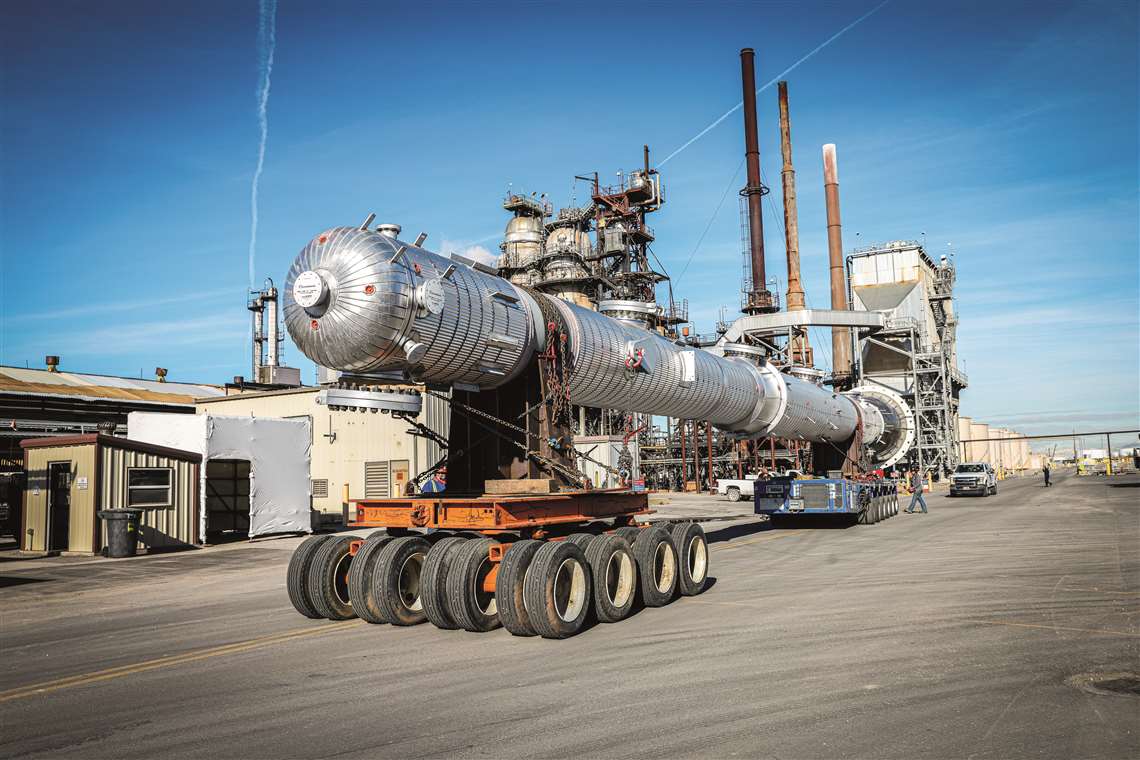 Mountain Crane was tasked with transporting a 129-foot-long vessel weighing more than 140,000 pounds through a refinery.
Mountain Crane was tasked with transporting a 129-foot-long vessel weighing more than 140,000 pounds through a refinery.
A six-line self-propelled E-steer Goldhofer was used to push the vessel with a light-weight four axle steerable dolly on the front end for steering. An E-steer trailer was used for tighter cornering and also to make one critical 3-point turn on the last stretch of the journey.
The PSTE was fitted with rocking turn tables that allowed the vessel to travel over multiple elevation changes throughout the refinery without creating any undue stress on the vessel during transport. The vessel was delivered to waiting 600-ton and 350-ton hydraulic cranes for standing and final installation. The transport, although short, was highly technical and involved extensive planning. It was executed flawlessly.
In-plant transporter
A client in Georgia approached Engineered Rigging about a difficult project with extremely tight clearances. After a review of the requirements, Engineered Rigging knew an in-plant transporter would provide the perfect solution and selected an Enerpac SPMT for the project. Engineered Rigging provided engineering support, equipment rental and technical oversight for installation of a new condenser, generator and steam turbine in the manufacturing facility.
 The Enerpac SPMT 600-360 is designed to operate in confined spaces.
The Enerpac SPMT 600-360 is designed to operate in confined spaces.
The Enerpac SPMT 600-360 features a minimized height and slim design, which makes it very easy to operate in confined spaces. Each wheel unit has a steering function as well as a lifting cylinder at its disposal. Wheel propulsion is established by wheel drives. The SPMT is operated by the Intelli-Drive Remote Controller.
The Enerpac SPMT’s ability to rotate without changing the midpoint, coupled with the pivoting wheel assemblies, allowed the operator to maneuver the condenser into place with clearances of less than 3 inches.
Shoulder span task
Mammoet set 72 shoulder spans on the northbound lanes of the 24-mile New Orleans Causeway in Louisiana by means of SPMT atop a barge. The shoulders give motorists and first responders a safe place to pull over during breakdowns or accidents.
 By utilizing the SPMTs instead of crane-barges, work could continue during marine weather conditions that would have otherwise been deemed unfavorable.
By utilizing the SPMTs instead of crane-barges, work could continue during marine weather conditions that would have otherwise been deemed unfavorable.
To reduce traffic disruptions, each of the 84-foot-long northbound spans were initially rough set approximately three feet from the final set location as a preparatory step to the lane closures. During night-time lane closures, the construction team would sawcut and remove the precast concrete guardrails from the existing bridge spans.
At the same time, Mammoet’s team would reconfigure the trailers to ensure accuracy of the final set. Once both tasks were complete, the spans were lifted and set into place. When the guard rail removal process began, the team could not stop until the new spans were set to ensure traffic could still safely pass.
Setting the spans using SPMTs rather than crane-barges increased safety of the span erection operation, decreased the risk of damaging the existing bridge and increased production. Despite the challenge of forecasting the rough seas in the shallow coastal Lake Pontchartrain, this method allowed for the installation of an average of four spans weighing approximately 147 tons each per day, instead of the planned three spans per day.
“Mammoet provided safe, efficient and high-quality solutions to some of the most complex portions of the project,” said Boh Bros’ Thad Guidry.
Late in 2020, Mammoet helped place 108 spans on the southbound lanes, using the SPMTs as a cantilever.
Hauling a big rock
In the small town of Hüven, Germany, an enormous stone protruded from the ground. Believed to be a billion years old, the stone was excavated and removed on an 18-axle Cometto SPMT.
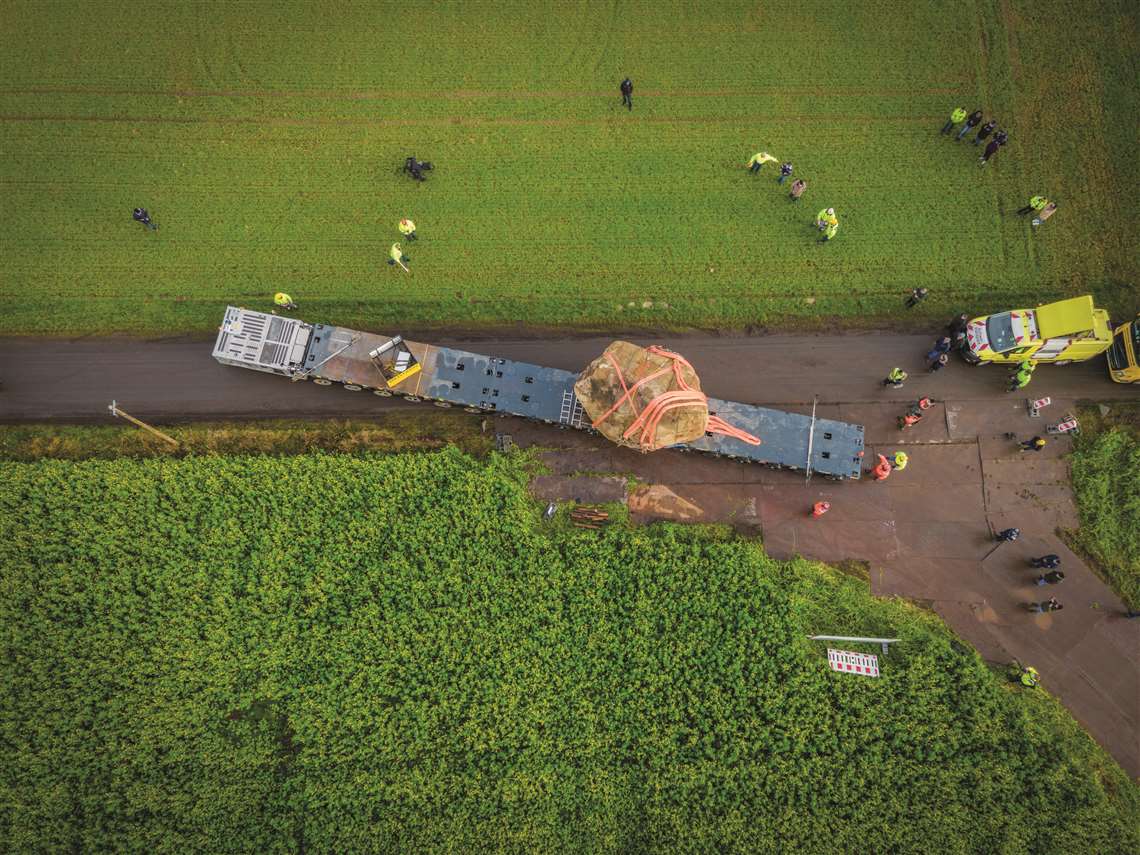 Once the rock arrived in the town center, a further 90-degree maneuver was necessary, utilizing additional electronic steering and the carousel drive of the Cometto SPMT.
Once the rock arrived in the town center, a further 90-degree maneuver was necessary, utilizing additional electronic steering and the carousel drive of the Cometto SPMT.
For decades the huge stone damaged farmers’ ploughs. Experts learned its true dimensions after its full exposure in 2020. The 5.8 meter-long, 4.9 meter-wide and 2.9 meter tall “Boulder of Hüven” has become a tourist attraction.
The stone, which was initially estimated to weigh 100 to 140 metric tons, was freed from the ground. A 370-meter-long road made of steel plates was laid across the field. A crane and the SPMT were position next to the enormous stone.
With the necessary precision, the crane lifted the stone and placed it on the SPMT. The first challenge was an overhead power line. The operator lowered the SPMT in travel mode by 350 millimeters to pass under the power line.
Next was a 90-degree bend and the exit onto the country road. With the help of the front steering mode and diagonal driving, the 29.30-meter-long combination eased itself into the lane with pinpoint precision. Once the rock arrived in the town center, a further 90-degree maneuver was necessary, utilizing additional electronic steering and the carousel drive of the Cometto SPMT.
STAY CONNECTED


Receive the information you need when you need it through our world-leading magazines, newsletters and daily briefings.
CONNECT WITH THE TEAM









